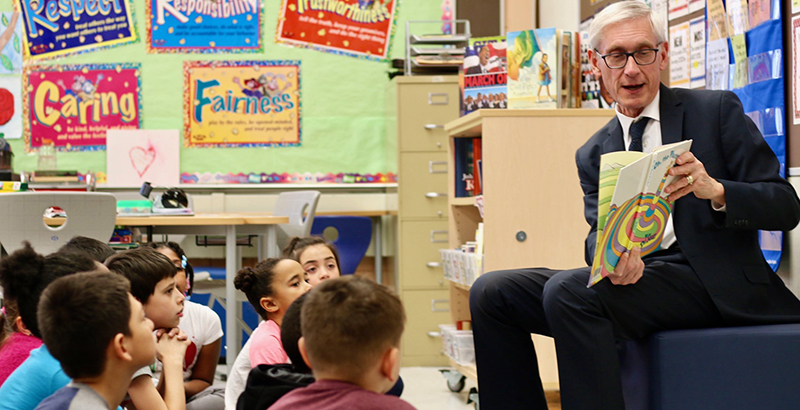Charlottesville Summit, 30 Years Later: Tony Evers on the Governors’ Gathering That Changed Education, the Good & Bad of Testing and What Equity Really Means

To commemorate the 1989 Education Summit in Charlottesville, Virginia, that convened 49 of the nation’s 50 governors to discuss a single policy issue — the education of America’s children — the Aspen Institute’s Education & Society Program is partnering with The 74 to produce a series of Q&A’s with distinguished leaders across politics, education and advocacy to reflect on the legacy of the summit and what lies ahead for public education. The interviews were conducted over the telephone, transcribed and edited for clarity and length. Participants were asked some of the same questions, but also queried specifically about their careers and backgrounds. These leaders share their thoughts on why the summit was a groundbreaking event, the strengths and shortcomings of education policy and what is required for propelling further gains for students. You can see all the interviews here.
Tony Evers is a career educator who was elected the 46th governor of Wisconsin in 2018, the first state superintendent in the United States to have become a state’s chief executive. A lifelong Wisconsin resident, Evers served as a teacher, principal, district superintendent and deputy state superintendent, as well as president of the Council of Chief State School Officers.
In this interview, he emphasizes the need for education leaders to pay attention to the out-of-school aspects of education — including poverty, affordable housing, health care and mass transit, and the effects they have on student learning — what the federal government’s role should be and how the growing consensus around social and emotional learning gives him hope for the future of American public education.
What do you think are the greatest accomplishments — relative to your career and your leadership of education in Wisconsin — that stem from the 1989 Education Summit and the standards-based reforms that resulted?
I was a school superintendent at the time, and I remember it was quite extraordinary. Public education as a state responsibility is, for all intents and purposes, silent in our federal constitution. To bring 49 out of the 50 governors together for this purpose was quite an important event. States coming together talking about expectations not only for our schools, but for our kids, and part of the discussion was about early childhood education, which hadn’t had much conversation ever at the national level.
Bringing people together and developing consistent expectations for states and for kids was a great start. It was responding to A Nation at Risk, and there was an opportunity for governors and others across the country to think about what public education was supposed to look like. Having people and states working together on these issues is important. If kids never moved from state to state or from district to district, it might not have been necessary, but the fact of the matter is kids do move, and having some consistency is an important thing.
What have you seen as the practical implications? Are there positive consequences that have been created by the standards-based policy agenda for Wisconsin?
Yes. It goes back to the idea that if you’re in Milwaukee or if you are in Cadott, Wisconsin — some of our largest school districts or smallest school districts — there should be the same expectations for kids and high standards, based on what we know about what children are able to developmentally deal with at different grade levels and age levels. That makes sense, and parents expect it and kids expect it. Having 49 out of the 50 states working together on these issues was a really important outcome. Certainly, there’s some things that we could have done differently, but at the end of the day, having some consistency in what our expectations are was a huge step forward.
Recognizing that those consistent expectations across communities created some essential infrastructure for improvement, what are the most important lessons you take away from these 30 years of standards-based education reform, and are there any unintended consequences that are important to address?
I would say the good around assessments was that we increased our acuity in measurement, and I think tests have become more meaningful going forward. It drove the technological aspect of testing. The downside is as we became more accurate in measuring, we moved quickly into high-stakes testing. I think that probably didn’t serve us very well, because we assumed that the tests were more than just a snapshot in time, that they really could tell us more than what they actually could. Therefore, we were making decisions about labeling kids in schools where that was kind of a shaky connection. That was something that we didn’t do very well.
In addition, there’s always been the issue of resources. There are places in our state where resources were slim to begin with, and as we added more responsibilities to local systems, they didn’t have the capability financially and otherwise to take this on. Federal contribution to schools is not very high — certainly, it’s important, but it’s not the most important resource. Those are the things that we could have done differently that would have helped.
Over time, we’ve also forgotten about things that also impact educational outcomes. The good news is that we’re morphing toward a different place around that, whether we talk about poverty or other issues that impact learning. Clearly, we are in a better place now because at least we understand that impact, whereas we were somewhat clueless about that in the past.
As you think about education and political leadership, what is it going to take to pursue educational excellence and equity moving forward toward the next 30 years?
First of all, we have to acknowledge what equity actually means. It doesn’t mean equality. It’s quite simple in the educational arena — if the kid needs an extra lift because of some circumstance in their lives, they should get it, and if it costs more, we should pay for it. That is something we’re beginning to understand. In addition, we’re beginning to understand how poverty and other issues, such as race, impact kids negatively, especially when they’re little. We are beginning to understand the social-emotional learning needs of kids better than we ever have before. It’s not that I believe that educators and education systems can’t do more and do it better, but I’ll tell you just as being governor: The issue of housing plays a role, the issue of health care plays a role, the issue of transportation plays a role. We have to connect the dots as to what the basic theory of action is, including criminal justice reform. How does that issue impact kids? It impacts kids very directly.
That includes making sure our teachers are culturally appropriate in their teaching. Then we have to have high-quality resources that address issues of culture and race in a proactive way. All that stuff has to be in place on the educational side, including resources. But if we don’t address issues that I mentioned, that for the most part have been viewed outside the realm of kids learning, we will not succeed.
We have a strong tradition of local leadership in education. How did you frame the role of state leadership and state policy in improving educational outcomes? What is the state uniquely positioned to do?
Well, I think it’s huge. That’s one of the reasons I ran for state superintendent. Frankly, one of the reasons I also ran for governor is that the state has a large part. Do I think we have to be partners with local education agencies? Absolutely. Do I believe that we have to be attuned to what a teacher and 20, 30 kids in a classroom are doing? Yes, we have to be attuned to that.
“If the kid needs an extra lift because of some circumstance in their lives, they should get it, and if it costs more, we should pay for it.”
But unless we provide some leadership at the state level, I just don’t believe we’re going to be able to create a future where all kids are learning at a high level. There are some things that transcend local leadership.
Having affordable housing does rely on the federal government being an active participant. Making sure that we do have good health outcomes for all people in the state of Wisconsin, especially our kids, that does have a federal impact, as do mass transit and criminal justice reform. All those things probably have a larger federal footprint than education does.
As state leaders, whether we’re state superintendents or governors or legislators, we should understand how important it is to connect the dots, making sure that we have affordable housing so that kids aren’t being evicted from their homes with their parents three or four times a year and going to three or four different schools. If we don’t understand how important that is, if we don’t understand how violence affects certain communities, or how abject poverty impacts learning, we will not succeed either.
What gives you the most optimism in this work?
The good news is there are some issues that are nonpartisan that impact the lives of children and allow them to succeed at a better level. I felt extraordinary confidence talking to teachers all across the state during the campaign and subsequent to that. They are still fired up and want to make sure that all kids learn at a high level. I also see people beginning to understand what connecting the dots actually means and how it impacts kids.
The whole issue of social and emotional learning has changed the dialogue around how we want to make sure kids are ready for school. That’s playing out in a positive way. We understand that early childhood education is a way to turn that around in a way that allows kids to be more ready for school. We’ve learned a lot more, and it’s not just all about this is what is going to be taught at this grade level.
For example, Common Core created an opportunity for teachers to be more creative and have more ownership in the classroom. It didn’t quite turn out that way, but for the most part, I think it did. That was a good stepping stone, but the next-best stepping stone is understanding how social and emotional learning impacts little kids and, frankly, adults also.
We’re learning a lot more and we know a lot more. I have a really talented group of cabinet members that are in charge of all these areas. They understand how important it is to connect the dots in order to have kids learn at a higher level. People that are not educators in these positions get it, and they are also advocating on our behalf and on the kids’ behalf.
Ross Wiener is vice president and executive director of the Aspen Institute’s Education and Society Program.
Get stories like these delivered straight to your inbox. Sign up for The 74 Newsletter

;)
